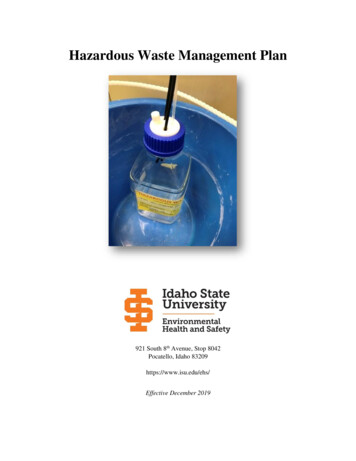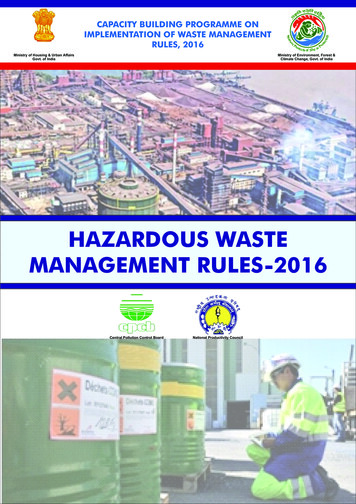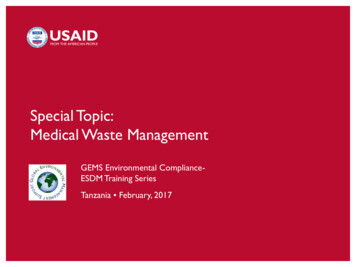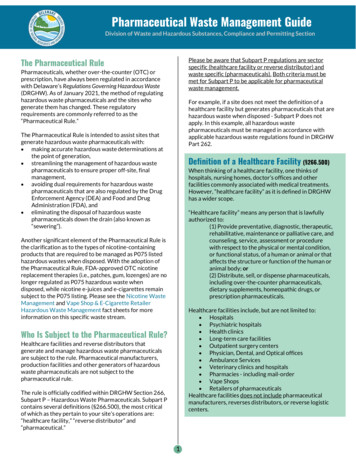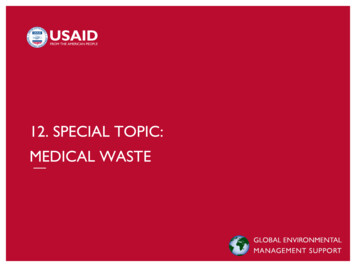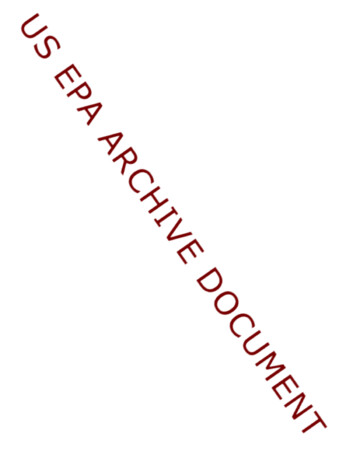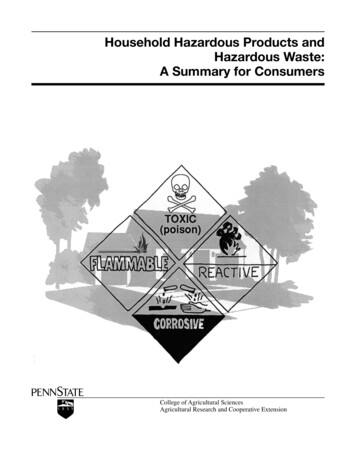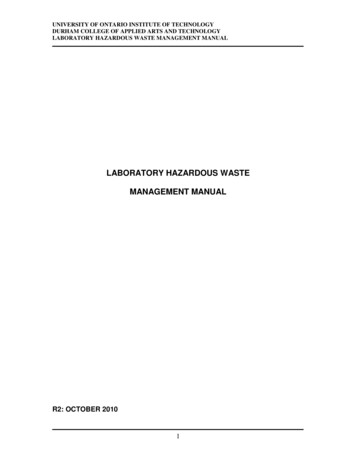
Transcription
UNIVERSITY OF ONTARIO INSTITUTE OF TECHNOLOGYDURHAM COLLEGE OF APPLIED ARTS AND TECHNOLOGYLABORATORY HAZARDOUS WASTE MANAGEMENT MANUALLABORATORY HAZARDOUS WASTEMANAGEMENT MANUALR2: OCTOBER 20101
UNIVERSITY OF ONTARIO INSTITUTE OF TECHNOLOGYDURHAM COLLEGE OF APPLIED ARTS AND TECHNOLOGYLABORATORY HAZARDOUS WASTE MANAGEMENT MANUALTABLE OF CONTENTS1.0INTRODUCTION2.0GENERAL REQUIREMENTS2.12.22.32.42.52.62.72.83.0CHEMICAL abelingStorageChemical CompatabilitySpecial Cases3.6.1 Asbestos3.6.2 Explosives3.6.3 Gas cylinders3.6.4 Mercury3.6.5 Peroxidizable Compounds3.6.6 Polychlorinated BiphenylsCollection SchedulesBIOHAZARDOUS ilities2.2.1 Waste Generator and Laboratory Supervisor2.2.2 Hazardous Waste Coordinators2.2.3 The University and CollegeWaste Minimization2.3.1 Purchasing2.3.2 Process Modification2.3.3 Product Substitution2.3.4 Good Laboratory PracticesPackagingLabelingStorageDisposalReleases to Sanitary SewerGeneralPackaging and Treatment of LiquidsPackaging and Treatment of SolidsPackaging and Treatment of Sharps4.4.1Needles and Blades4.4.2 Glassware and PlasticwareLabelingStorageSpecial Pick-up and Disposal of Untreated Biological WasteRADIOACTIVE WASTES5.1Liquid Scintillation Counting Vials2
UNIVERSITY OF ONTARIO INSTITUTE OF TECHNOLOGYDURHAM COLLEGE OF APPLIED ARTS AND TECHNOLOGYLABORATORY HAZARDOUS WASTE MANAGEMENT MANUAL6.0SHARP WASTES6.1Needles and Blades6.1.1 Packaging6.1.2 Treatment of Biologically Contaminated Needles and Blades6.1.3 Treatment of Radioactively Contaminated Needles and Blades6.1.4 Treatment of Chemically Contaminated Needles and Blades6.1.5 Labeling6.1.6 Storage and Disposal6.2Glassware and ingBiologically Contaminated GlasswareRadioactively Contaminated GlasswareChemically Contaminated GlasswareLabelingStorage and DisposalMIXED WASTESAPPENDIX 1:CHEMICAL INCOMPATIBILITIESAPPENDIX 2:CONTACT PERSONS WITHIN THE UNIVERSITY AND COLLEGEAPPENDIX 3CHEMICAL WASTE HANDLING PROCEDUREAPPENDIX 4WASTE COLLECTION INVENTORY FORM3
UNIVERSITY OF ONTARIO INSTITUTE OF TECHNOLOGYDURHAM COLLEGE OF APPLIED ARTS AND TECHNOLOGYLABORATORY HAZARDOUS WASTE MANAGEMENT MANUAL1.0INTRODUCTIONA variety of hazardous wastes may be produced at the University and College fromresearch and teaching laboratories. The University and College are committed to theproper and safe management of these wastes in order to protect employees, studentsand the public and to comply with all applicable legislation.This manual and the procedures contained herein apply to all laboratory operations withinthe University and College which generate hazardous chemical, biological, radioactive orsharp wastes. The objective of the manual is to provide information and instructions tohandle safely, and in an environmentally responsible manner all the hazardous wastesproduced in University and College laboratories.The basic elements of the Hazardous Waste Management program are: Waste minimizationPackaging requirementsLabeling requirementsStorage requirementsWaste generators are responsible for proper identification, segregation, packaging andlabeling of all hazardous wastes which originate from their operations.The procedures in this manual are mandatory when preparing waste for disposal. Wastenot prepared according to these procedures will not be accepted for disposal by theUniversity and College.2.0GENERAL REQUIREMENTS2.1LegislationThe proper handling, transport and disposal of hazardous wastes are governed by avariety of provincial and federal legislation and local by-laws These include: Ontario Environmental Protection Acto Air Pollution – General regulationo Waste Management – General regulationo Waste Management – PCB regulationo Guideline C-4. The Management of Biomedical Waste in Ontario Transportation of Dangerous Goods Act (Federal) Environmental Protection Act (Federal) Environmental Contaminants Act (Federal)o Guidelines for the Management of PCB Wastes Nuclear Safety and Control Act (Federal)o Packaging and Transport of Nuclear Substances regulationo Canadian Nuclear Safety Commission Regulatory Guides Pest Control Products Act (Federal)4
UNIVERSITY OF ONTARIO INSTITUTE OF TECHNOLOGYDURHAM COLLEGE OF APPLIED ARTS AND TECHNOLOGYLABORATORY HAZARDOUS WASTE MANAGEMENT MANUAL2.2 Pesticides Act and regulations (Ontario) City of Oshawa By-Law 95-95 “To regulate the discharge of water and waste into thepublic storm sewer system”.Responsibilities2.2.1Waste Generator and Laboratory Supervisor(1)Preplanning experiments to include provisions for handling of hazardous wastesgenerated as a result of the work;Preplanning experiments to minimize the amounts of waste generated;Identifying, classifying and segregating wastes according to the proceduresoutlined in this manual;Proper packaging of the wastes according to the procedures outlined in thismanual;Proper labeling of the wastes and maintenance of the records required by thismanual;Safely storing the wastes in the laboratory or other appropriate area accordingthe procedures outlined in this manual;Identifying to their local waste coordinator, the need for pickup and disposal ofhazardous waste.Safely transporting the wastes to the designated pickup locations according tothe procedures and schedules outlined in this manual; andPromptly disposing of unwanted materials so that they do not accumulate in us Waste CoordinatorsThe Hazardous Waste Coordinators for the University and College are listed in Appendix2. They act as a local resource to coordinate waste pick-up and disposal and provideassistance in interpreting the requirements of this manual and in dealing with unusualwastes. They have the following responsibilities:(1)(2)(3)(4)(5)Receive the waste at the central storage or pick-up location and ensure that itis properly labeled and the classifications are accurate.Retain the “Waste Collection Inventory” forms as a record of the generator andthe types and quantities of wastes.Review the waste inventory and coordinate with the other waste coordinators thepickup of the waste by the external contractor.Enter the required information into the chemical waste database.Sign copies of the waste manifest as completed by the disposalcontractor and forward them the appropriate authority for final authorization.2.2.3The University and College(1)Arranging for external contractors to pick up and properly dispose of hazardouswastes;Providing waste generators and laboratory workers with appropriate proceduresfor managing hazardous wastes;Verifying compliance and enforcing the use of the appropriate procedures;Auditing the effectiveness of the hazardous waste management program.Funding the costs of disposal of hazardous wastes.(2)(3)(4)(5)5
UNIVERSITY OF ONTARIO INSTITUTE OF TECHNOLOGYDURHAM COLLEGE OF APPLIED ARTS AND TECHNOLOGYLABORATORY HAZARDOUS WASTE MANAGEMENT MANUAL2.3Waste MinimizationDisposing of hazardous wastes is very costly. It is therefore very important the wastegenerators take all reasonable steps to minimize the generation of hazardous wastes.The following steps should be actively considered at all times.2.3.1 Purchase hazardous materials in the smallest quantities needed. Stockpilinghazardous materials creates additional problems with respect to security and usuallyresults in excessive disposal costs for unused material.Donations in bulk of hazardous materials should be avoided. This can result in thereceipt of unwanted hazardous materials with the resultant liability for costly disposal.Accept only those donations which will be used within one year. Due to regulatoryrequirements, donations involving radioactive materials or biological agents willrequire prior approval from the UOIT Radiation Safety Committee or and theBiosafety Committee.Before purchasing chemicals, prepare a written procedure detailing the method ofdisposal of the chemical and any reaction products.2.3.2 Process ModificationExamine experimental protocols to, if possible, eliminate materials that would resultin the generation of hazardous wastes, or would generate the least hazardousproduct.Review experimental protocols to determine whether quantities of hazardousmaterials can be reduced by, for example, use of microscale methods.2.3.3 PurchasingProduct SubstitutionEvaluate experimental protocols to determine if a less hazardous material may beused. e.g.oooooo2.3.4 Toluene substituted for benzeneA thermocouple thermometer instead of a mercury thermometerAlcohol thermometers instead of mercury thermometersNon-flammable liquid scintillation cocktails instead of flammable onesShort-lived radionuclides instead of longer-lived onesnon-radioactive DNA labeling instead of radioactive DNA labeling.Good Laboratory PracticesPlan for hazardous waste disposal as part of all experimental protocols.Record the date on all containers when they are received so that older ones can beused first.Avoid storing excessive quantities of hazardous materials.Ensure that all containers are properly labeled with the proper scientific name of thematerial. Unused materials must follow the WHMIS requirements. Waste materials donot require WHMIS labeling, but they must be labeled according the requirements inthis manual.6
UNIVERSITY OF ONTARIO INSTITUTE OF TECHNOLOGYDURHAM COLLEGE OF APPLIED ARTS AND TECHNOLOGYLABORATORY HAZARDOUS WASTE MANAGEMENT MANUAL Do not mix hazardous with non-hazardous products. Such mixed materials must bedisposed of as hazardous waste thereby increasing costs.Do not mix solid and liquid waste; the disposal methods for the two are different andmixing them may increase costs.On termination of a research project ensure all hazardous materials and containersare labeled and those no longer required are disposed of.Remember, all containers of hazardous waste must be identified with the materialsthey contain. Unknowns will not be accepted by contractor for disposal.It is extremely expensive to dispose of unknown materials and the costs to analyzeand dispose of such material will be charged back to the generator.2.4PackagingWaste materials must be packaged in a manner that will allow them to be stored ortransported without the danger of spillage, explosion of hazardous vapours escaping.The detailed requirements for the different categories of waste materials are given in theappropriate sections of this manual.The waste generator bears the primary responsibility for proper packaging.Any hazardous waste that is improperly packaged will not be accepted fordisposal.2.5LabelingWaste materials must be labeled in a manner that will allow the hazards to be clearly andaccurately identified. Any unlabeled containers will not be accepted for disposal andthe generator will bear the cost of identifying the material prior to disposal. 2.6Storage 2.7Appropriate waste labels must be attached to each waste container (See Figure 1);An accurate inventory must be maintained of the material being added to each wastecontainer using the appropriate label.Containers must be in good condition and should remain closed unless waste isbeing added.Hazardous waste must be stored in a safe location outside of the normal work area ofthe laboratory;Hazardous waste should be removed from the laboratory on a regular basis and notallowed to accumulate;Liquid hazardous waste containers stored in laboratories should be periodicallyinspected for leaks;Disposal Hazardous materials must never be disposed of in the regular garbage. Suchpractice is dangerous and illegal.7
UNIVERSITY OF ONTARIO INSTITUTE OF TECHNOLOGYDURHAM COLLEGE OF APPLIED ARTS AND TECHNOLOGYLABORATORY HAZARDOUS WASTE MANAGEMENT MANUAL 2.8Hazardous materials must not be flushed down drains as a method of disposal. Thispractice is illegal according to provincial legislation and the by-laws of the RegionalMunicipality of Durham. It may also lead to dangerous reactions, damage to thedrainage system, dissemination of odours to other areas of the building and create apotential hazard to personnel working on the system.Releases to Sanitary SewerThe following are specifically prohibited from discharge to the sanitary sewer system: pH less than 6.0 or greater than 10.5;two or more separate liquid layers;a temperature greater than 60 degrees Celsius;total mercury greater than 0.01 mg/L;acute hazardous waste chemicals;combustible liquids;fuel;dyes or colouring materials which could pass through a sewage works and discolourthe sewage works effluent;hazardous waste chemicals;ignitable waste;pathological waste;pesticides;reactive wastes;severely toxic waste;PCBs;Radioactive waste, unless in accordance with a license issued by the CanadianNuclear Safety CommissionTable 2.1 lists discharge limits into the sanitary sewer for a number of parameters as setout by the Regional Municipality of Durham By-law 41-2009. Note that it is prohibited todeliberately add water to the discharge for the purposes of dilution in order to meet theselimits.8
UNIVERSITY OF ONTARIO INSTITUTE OF TECHNOLOGYDURHAM COLLEGE OF APPLIED ARTS AND TECHNOLOGYLABORATORY HAZARDOUS WASTE MANAGEMENT MANUALTable 2.1 – Limits for Sanitary Sewer DischargeParameterBiochemical Oxygen 1Cyanide e0.05Total Kjeldahl Nitrogen1001,4-dichlorobenzene0.08Oil & Grease – Animal &Vegetable150cis-1,2-dichloroethyleneOil & Grease – Mineral cs (4AAP)1Ethyl benzene0.16Phosphorus (total)10Methylene chlorideSuspended solids trachloroethylene421.41Aluminum (total)50Toluene0.27Antimony (total)5Trichloroethylene0.4Arsenic (total)1Xylenes (total)1.4Di-n-butyl phthalate0.080.012Cadmium (total)0.7Chromium (total)2Bis(2-ethylhexyl) phthalateCobalt (total)5Methyl Ethyl KetoneCopper (total)3StyreneLead (total)1Manganese (total)5Molybdenum (total)5Nickel (total)80.2PCBs0.0012Nonylphenols0.02Selenium (total)1Nonylphenol ethoxylates0.2Silver (total)5Tin (total)5Titanium (total)5Zinc (total)2Regional Municipality of Durham By-law 43-2004 as amended by By-law 41-2009.9
UNIVERSITY OF ONTARIO INSTITUTE OF TECHNOLOGYDURHAM COLLEGE OF APPLIED ARTS AND TECHNOLOGYLABORATORY HAZARDOUS WASTE MANAGEMENT MANUAL3.0CHEMICAL WASTESChemical wastes are collected for disposal by a licensed chemical waste contractor asrequired. The generator is responsible for contacting their local waste coordinator toidentify the need for a waste pickup and for bringing the waste to the central collectionlocation at a specified date and time. At that time the waste will be inspected and, ifappropriately packaged and labeled, accepted for disposal.Any waste not appropriately packaged and labeled will not be accepted fordisposal and the generator will be required to return it to their laboratory.Chemical wastes must be kept in the generating laboratory or other designated storagearea in a safe location between scheduled pickups. If material is generated whichrequires special handling or immediate disposal contact the local Waste Coordinator (seeAppendix 2)3.1DefinitionGenerally, waste is defined as any surplus, unneeded or unwanted material. It is usuallythe laboratory worker or supervisor who decides whether to declare a given laboratorymaterial a waste.Note that if a chemical is not a waste, then the WHMIS requirements apply. Once thematerial has been declared a waste, then the waste labeling and storage requirementsoutlined in this manual apply.Chemical waste includes solids, liquids or gases containing or contaminated with any ofthe following: 3.2Flammable or combustible liquids (organic solvents)Corrosives (strong acids and bases)Reactives (oxidizers, cyanides, sulphides, explosives, unstable materials, waterreactive materials)Toxic materials (mutagens, carcinogens, acutely toxic materials)Polychlorinated biphenyls ( 50 ppm concentration)Leachate toxic materials (heavy metals, pesticides)Non returnable gas cylindersPackaging Wastes must be stored in containers which are compatible with the material stored.For example corrosive materials should be stored in glass or plastic containers, notmetal ones. Hydrofluoric acid must not be stored in glass containers. Do not completely fill containers of liquid waste. Leave between 20-25 % of air spaceto allow for vapour expansion and to reduce the potential for spills when movingcontainers. Compatible wastes can be accumulated within a common container, however caremust be taken to ensure that the chemicals are compatible.10
UNIVERSITY OF ONTARIO INSTITUTE OF TECHNOLOGYDURHAM COLLEGE OF APPLIED ARTS AND TECHNOLOGYLABORATORY HAZARDOUS WASTE MANAGEMENT MANUAL Never mix incompatible chemicals together in a single container. This has thepotential to cause heat generation, gas evolution or other reaction and asubsequent explosion. Flammable and combustible solvents shall be segregated and packaged separatelyinto two categories:ooHalogenated solventsNon-halogenated solventsThe two should not be mixed as there is a premium cost for disposal of halogenatedsolvents. 3.3Solvent safety cans should be used to collect and temporarily store large volumes( 10-20 L) of flammable organic waste solvents. The generating laboratory isresponsible for providing these containers and they will be returned to the laboratorywhen the material is bulked at the time of waste collection.LabelingAttach a Chemical Waste Label directly to each waste container. These labels areavailable from UOIT Chemical Stores or from the Waste Coordinators.All information requested on the label must be provided. Chemical generic names of thechemicals must be listed. No abbreviations, acronyms or trade mark names are to beused. Vague categories such as “solvent waste” are not acceptable.See Figure 1 for an example of the chemical waste label.3.4StorageIn addition to the general storage requirements, these specific requirements forchemicals must be followed: Chemical waste is to be stored in a safe, out-of-the-way location in the generator’slaboratory or other designated area between scheduled collection days.Flammable solvents should be stored in a flammable storage cabinet. Ifcircumstances require that they be stored in fumehood, they should be limited tosmall amounts and be kept in a location such that they do not interfere with work inthe fumehood or obstruct the airflow and decrease the fumehood efficiency.Waste should be segregated according to compatibility groups such as acids, bases,flammables, oxidizers and water reactives.Dispose of aging containers promptly. Some chemicals are time sensitive and maydegrade into very hazardous by-products. e.g. ethers may degrade to form explosiveorganic peroxides. Where safety considerations would indicate not waiting until thescheduled collection day, contact the local Waste Coordinator.11
UNIVERSITY OF ONTARIO INSTITUTE OF TECHNOLOGYDURHAM COLLEGE OF APPLIED ARTS AND TECHNOLOGYLABORATORY HAZARDOUS WASTE MANAGEMENT MANUALFIGURE 1 – CHEMICAL WASTE LABELDurham CollegeUOITCHEMICAL WASTEName of GeneratorID#Building and Room NumberPhone #Major Chemical ConstituentsApproximate %NO SHARPS, BIOHAZARDS OR RADIOACTIVESCheck the appropriate boxes Halogenated Solvents Non-halogenated Solvents Unstable/Explosive Air/Water Reactive Other (specify) Acid Alkali Aqueous Inorganic Organic PeroxideWASTE WILL NOT BE ACCEPTED IFTHIS LABEL IS INCOMPLETE12
UNIVERSITY OF ONTARIO INSTITUTE OF TECHNOLOGYDURHAM COLLEGE OF APPLIED ARTS AND TECHNOLOGYLABORATORY HAZARDOUS WASTE MANAGEMENT MANUAL3.5Chemical CompatibilityWhen preparing chemical waste for disposal it is the generator’s responsibility to ensurethat incompatible chemicals are not mixed in the same container. The first step indetermining chemical incompatibilities is to review the Material Safety Data Sheet whereincompatibilities will be listed in the section on reactivity.Some general examples are: Acid-reactive compounds (e.g. cyanides, sulphides) which liberate gaseous productswhen acidified should not be mixed with any inorganic acid (e.g. sulphuric orhydrochloric acid).Organic acids (e.g. glacial acetic acid) should be segregated from inorganic acids.Generally inorganic acids are oxidizing agents while some organic acids may beeither reducing agents or combustible.Water reactive materials (e.g. sodium, potassium) should be kept well away from anywater sources.Oxidizers (i.e. any inorganic compound that assists fire such as hydrogen peroxide,lead nitrate) should never be mixed with organic materials (e.g. organic bases suchas pyridine, aniline, amines, flammable solvents such as toluene, acetone) orreducing agents (e.g. water-reactive chemicals such as sodium).Perchloric acid, although an inorganic acid, is a powerful oxidizing agent and shouldbe considered a powerful oxidizer in its concentrated form.Appendix 1 of this manual provides a table giving general classes of incompatiblechemicals. For specific chemicals, consult the material safety data sheet.3.6Special CasesThe preceding procedure deals with most common teaching and research chemicalwastes. On occasion some wastes may be generated which require special handling.Some of these are:3.6.1AsbestosAsbestos containing materials such as gloves, heating pads etc. should beplaced in a plastic bag, sealed, and marked “asbestos containing waste”.Asbestos waste must be managed according to the requirements of OntarioRegulation 347 - General Waste Management under the EnvironmentalProtection Act.Contact the local Waste Coordinator to arrange disposal.3.6.2ExplosivesDo not handle explosive materials. Examples of explosive materials includetrinitrated compounds, dry picric acid ( 29% by weight water content), fulminatedmercury, heavy metal azides. These materials require special handling fordisposal. These materials must be checked frequently for signs of deteriorationand aging. Such signs include “sweating” of a container, bulging, crystalformation around the cap. Deteriorating explosive materials are potentially moredangerous to handle than new explosives.Contact the local Waste Coordinator to arrange disposal.13
UNIVERSITY OF ONTARIO INSTITUTE OF TECHNOLOGYDURHAM COLLEGE OF APPLIED ARTS AND TECHNOLOGYLABORATORY HAZARDOUS WASTE MANAGEMENT MANUAL3.6.3Gas CylindersGas cylinders should be treated as high energy sources. Use the smallest sizenecessary to do the work. Prior to purchasing, check if empty cylinders can bereturned to the supplier. Disposing of gas cylinders is extremely expensive anddifficult.3.6.4MercuryAll free liquid mercury should be collected in a leak-proof container. Mercurycontaminated solids such as glassware, gloves and cleanup materials should bepackaged separately.3.6.5Peroxidizable CompoundsPeroxidizable compounds should be ordered in small quantities (less than 6months’ supply) and dated when the container has been opened. Even if acommercial inhibitor has been added by the manufacturer, organic peroxideformation can begin within 6 months following exposure to air. Organic peroxidesare explosive. The ordering of smaller quantities and the reduction of the volumeof these materials in storage encourages the quick turnover of inventory andreduces the likelihood of peroxide formation.The following materials have the potential to form organic peroxides: 3.6.6Ethers such as Isopropyl ether, dimethyl ether, diethyl thylene glycolDioxanePolychlorinated Biphenyls (PCBs)The handling of PSC contaminated material requires special consideration forhandling, storage and disposal. In Ontario, any waste material with aconcentration of PCBs in excess of 50 ppm is considered to be PCBcontaminated. Sources of PCBs include transformers containing askarels. PCBswere also used in capacitors, hydraulic equipment, electromagnets, heat transferequipment and vapour diffusion pumps.If material is suspected to contain PCBs it should not be mixed with other wastes.For testing of the material, contact the local Waste Coordinator.3.7Collection SchedulesCollection and disposal will be arranged by the Waste Coordinators as required. Therewill normally be at least two scheduled collections per year, at the end of the fall term inDecember and the end of the spring term in May.Special pickups may be arranged by contacting the local Waste Coordinator.14
UNIVERSITY OF ONTARIO INSTITUTE OF TECHNOLOGYDURHAM COLLEGE OF APPLIED ARTS AND TECHNOLOGYLABORATORY HAZARDOUS WASTE MANAGEMENT MANUAL4.0BIOHAZARDOUS WASTES4.1GeneralMaterials contaminated with hazardous biological agents must be collected in theappropriate containers and sterilized or disinfected before disposal.The following general principles must be followed with respect to the generation anddisposal of hazardous waste:(1)(2)(3)(4)Minimize the generation of hazardous waste by reducing, reusing and recyclingwhere possible.Segregate biohazardous and non-biohazardous waste at the point of generation.All biohazardous waste must be rendered harmless by either chemicaldecontamination or heat sterilization before disposal.Steam sterilization is generally not recommended for laboratory wastecontaminated with or containing a combination of viable biological agents andsignificant amounts of hazardous chemical or radioactive materials.Biological waste includes: 4.2liquids such as used cell culturing media, supernatant, blood or blood fractions(serum), etc., which contain viable biological agents;materials considered pathological, including any part of the human body, tissues andbodily fluids, but excluding fluids, extracted teeth, hair, nail clippings and the like thatare not infectious;any part of an animal infected [or suspected to be infected] with a communicabledisease;non-sharp, solid laboratory waste (empty plastic cell culture flasks and petri dishes,empty plastic tubes, gloves, wrappers, absorbent tissues, etc.) which may be, or isknown to be, contaminated with viable biological agents;all sharp and pointed items used in medical care, diagnosis, and research, includingthe manipulation and care of laboratory animals, which should be consideredpotentially infectious;laboratory glassware which is known or suspected to be contaminated withhazardous biological agents.Packaging and Treatment of Liquids Collect liquids in leak-proof containers such as flasks or bottles.Liquid waste containers designed to withstand autoclaving temperatures must beused when steam sterilization is utilized. To allow pressure equalization, they shouldnot be sealed.Containers of liquid waste must be placed into an autoclavable tray or pan ofsufficient capacity to contain all liquid in the event of vessel failure or breakage insidethe autoclave chamber. Use extreme caution when handling autoclaved liquids sincethey are hot and may boil over.Following steam sterilization, innocuous liquids may be disposed of via the laboratorydrainage system. Flush with sufficient clean water to purge the drain immediatelyafter disposal of all liquids.15
UNIVERSITY OF ONTARIO INSTITUTE OF TECHNOLOGYDURHAM COLLEGE OF APPLIED ARTS AND TECHNOLOGYLABORATORY HAZARDOUS WASTE MANAGEMENT MANUALNOTE: If the liquid contains hazardous chemicals or radioactive material, it maynot be disposed of via the laboratory drainage system. In this case the liquidshould be disposed of as either radioactive or chemical waste as the case may be.4.3Packaging and Treatment of Solids Non-sharp, solid laboratory waste (empty plastic cell culture flasks and petri dishes,empty plastic tubes, gloves, wrappers, absorbent tissues, etc.) which may be, or isknown to be, contaminated with viable biological agents should be collected inautoclavable bags. These plastic bags display the biohazard warning symbol andare available from Fisher Scientific.Autoclavable bags of solid waste should be closed but not sealed airtight to allowsteam penetration before they are placed into the autoclave chamber. Afterautoclaving and cooling, these bags of autoclaved waste must be placed into a blackplastic garbage bag which will conceal the biohazard symbol which is no longerapplicable.For laboratories generating large volumes of agar gel in disposable petri dishes andtubes requiring sterilization, such waste should be collected in a white plastic 20 litrepail in the laboratory. Autoclavable bags filled with plasticware containing agar geltend to leak fluids during and after the sterilization process. The pail will contain theliquids released by the agar gel. After autoclaving and cooling, the pail must then beplaced beside other waste awaiting removal by caretaking staff.Do not pour melted agar into sink or floor drains. Allow it to cool and solidify fordisposal as a solid waste.Note: Autoclavable bags should be used for solid, non-sharp, hazardous biologicalwaste only and disposed of appropriately. They should not be used for thecollection of other solid hazardous or nonhazardous waste that may require othertreatment or disposal methods.4.4Packaging and Treatment of SharpsThe term "sharp" is often used as a catch-all expression for any and all sharp or pointeditems such as broken glassware, scalpel and razor blades, lancets, hypodermic syringeswith needles, etc., which can cause cuts or puncture injuries. In this manual, sharp wasteis subdivided into two categories: 4.4.1Needles and bladesGlass and other sharp or pointed wasteNeedles and BladesNeedle and blade waste is hypodermic, surgical, suture, or IV needles, syringes withneedles, lancets, scalpels, blades and similar metallic sharp or pointed items for disposalthat are capable of causing punctures, cuts, or tears in skin or membranes. according to the principles of universal blood and body fluid precautions, all needlesand blades used in medical
LABORATORY HAZARDOUS WASTE MANAGEMENT MANUAL 2 TABLE OF CONTENTS 1.0 INTRODUCTION 2.0 GENERAL REQUIREMENTS 2.1 Legislation 2.2 Responsibilities 2.2.1 Waste Generator and Laboratory Supervisor 2.2.2 Hazardous Waste Coordinators 2.2.3 The University and College 2.3 Waste Minimization 2.3.1 Purchasing 2.3.2 Process Modification
